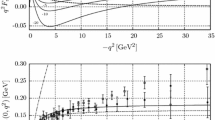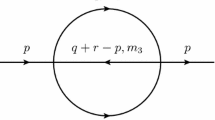Summary
It is shown that theSU 2 ×SU 2 invariant pion-kaon Lagrangians constructed by using the matrix method of Gürsey, or the covariant derivative method of Weinberg, or by reduction from anSU 3 ×SU 3 invariant Lagrangian for the pseudoscalar meson octet, respectively, do not all give the same result. It is further shown that only the pion-kaon Lagrangian obtained by using the matrix method can be expressed in general in the current-current Sugawara form in terms of the vector and the axial vector pion currents and the strangeness-changing currents. The origin of this discrepancy is due to a pion-kaon interaction term that is itselfSU 2 ×SU 2 invariant and hence may be multiplied by an arbitrary parameter without spoiling theSU 2 ×SU 2 invariance of the Lagrangian. The matrix method, or equivalently the current-current Sugawara form, and the reduction method prescribe definite, though different, values for this parameter, whereas the covariant derivative method leaves the parameter undetermined. Since the pionkaon scattering lengths depend on the value of this parameter, it is possible, in principle, to distinguish the various alternatives experimentally, if the pion-kaon scattering lengths can be measured to an accuracy of the order of (10 ÷ 20) percent. In particular, such a measurement would provide a direct test of the current-current Sugawara form for theSU 2 ×SU 2 invariant pion-kaon Lagrangian.
Riassunto
Si mostra che i lagrangiani invariantiSU 2 ×SU 2 pione-kaone costruiti col metodo delle matrici di Gürsey, o col metodo delle derivate covarianti di Weinberg, o per riduzione da un lagrangiano invarianteSU 3 ×SU 3 relativo all’ottetto di mesoni pseudoscalari non danno tutti lo stesso risultato. Si mostra poi che solo il lagrangiano pione-kaone ottenuto con il metodo delle matrici può essere espresso in generale nella forma corrente-corrente di Sugawara in termini delle correnti vettoriale e vettoriale assiale di pioni e delle correnti che cambiano la stranezza. L’origine della diversità risiede in un termine di interazione pione-kaone che è di per se stesso invariante adSU 2 ×SU 2 e quindi si può moltiplicare per un parametro arbitrario senza intaccare l’invarianzaSU 2 ×SU 2 del lagrangiano. Il metodo delle matrici, come la forma corrente-corrente di Sugawara e il metodo di riduzione, prescrivono per questo parametro valori definiti, sebbene diversi, mentre il metodo delle derivate covarianti lo lascia indeterminato. Dal momento che le lunghezze di scattering pione-kaone dipendono dal valore di questo parametro, si può, in via di principio, distinguere sperimentalmente le varie alternative, se si può misurare la lunghezza suddetta con una accuratezza del (10 ÷ 20) per cento. In particolare da tale misura si può avere una prova diretta della forma corrente-corrente di Sugawara per il lagrangiano invarianteSU 2 ×SU 2 pione-kaone.
Реэюме
Покаэывается, чтоSU 2 ×SU 2 инвариантный пион-каонный Лагранжиан, сконструированный с помошью матричного метода Гюрсея, метода ковариантных проиэводных Вейнберга и путем приведенияSU 3 ×SU 3 инвариантного Лагранжиана для октета псевдоскалярных меэонов, не является одним и тем же. Затем покаэывается, что только пион-каонный Лагранжиан, полученный с испольэованием матричного метода, может быть выражен в обшем виде в ток-токовой форме Сугавара, в терминах векторного и аксиально-векторного пионных токов и токов с иэменением странности. Происхождение зтого расхождения обусловлено членом пион-каонного вэаимодействия, который сам являетсяSU 2 ×SU 2 инвариантным и, следовательно, может быть умножен на проиэвольный параметр, не нарущаяSU 2 ×SU 2 инвариантность Лагранжиана. Матричный метод, или зквивалентная ему ток-токовая форма Сугавара, и метод приведения предписывают определенные, хотя и раэличные, величины для зтого параметра, в то время как метод ковариантных проиэводных оставляет зтот параметр неопределенным. Так как длины пион-каонного рассеяния эависят от величины зтого параметра, то, в принципе, воэможно раэличить зкспериментально раэлиные альтернативы, если длины пион-каонного рассеяния могут быть иэмерены с точностью (10÷20) процентов. В частности, такое иэмерение обе-снечило бы прямую проверку ток-токовой формы Сугавара дляSU 2 ×SU 2 инвариантного пион-каонного Лагранжиана.
Similar content being viewed by others
References
H. Sugawara andM. Yoshimura:Phys. Rev.,173, 1419 (1968);J. A. Cronin andG. S. Guralnik:Phys. Rev.,184, 1803 (1969);M. Gell-Mann: inProceedings of the Nobel Symposium (New York, N. Y., 1968), p. 387.
F. Gürsey:Nuovo Cimento,16, 230 (1960);Ann. of Phys.,12, 91 (1961);Acta Phys. Austriaca,5, 186 (1968);P. Chang andF. Gürsey:Phys. Rev.,164, 1752 (1967);169, 1397E (1968).
S. Weinberg:Phys. Rev.,166, 1568 (1968);J. Wess andB. Zumino:Phys. Rev.,163, 1727 (1967).
P. H. Weisz:Phys. Rev.,185, 2015 (1969).
A. Ebrahim: Ph. D. Thesis, Yale University (1972) (unpublished).
B. Zumino:Phys. Lett.,25 B, 349 (1967).
F. Gürsey andM. Serdaroğlu:Nuovo Cimento,7 A, 584 (1972);9 A, 263E (1972);M. Serdaroğlu: Ph. D. Thesis, Middle East Technical University (1972) (unpublished).
This general chiral transformation law has been used byI. Bars:Phys. Rev. D,2, 1630 (1970).
M. Gell-Mann andM. Lévy:Nuovo Cimento,16, 705 (1960);J. Wess andB. Zumino:Phys. Rev.,163, 1727 (1967);S. Weinberg:Phys. Rev.,166, 1568 (1968);L. S. Brown:Phys. Rev.,163, 1802 (1967);I. Bars:Phys. Rev. D,2, 1630 (1970).
R. F. Dashen andY. Frishman:Phys. Rev. Lett.,22, 572 (1969).
S. Weinberg:Phys. Rev. Lett.,17, 616 (1966).
J. J. Sakurai: inProceedings of the Fifth Eastern Theoretical Physics Conference (New York, N. Y., 1967), p. 81.
An analogous situation occurs for the chiralSU 2 ×SU 2 invariant pion-nucleon Lagrangian in which case the derivative pion-nucleon interaction term, which isSU 2 ×SU 2 invariant by itself, appears in the Lagrangian with an arbitrary parameter. SeeF. Gürsey:Nuovo Cimento,16, 230 (1960);Ann. of Phys.,12, 91 (1961);Acta Phys. Austriaca,5, 186 (1968). For this case, however, the parameter has to be fixed experimentally.
Author information
Authors and Affiliations
Additional information
Work supported in part by the Turkish Scientific and Technical Research Council under contract No. TBAG-159.
Rights and permissions
About this article
Cite this article
Ebrahim, A., Serdaroglu, M. Current-current sugawara form and pion-kaon scattering lengths. Nuov Cim A 21, 249–264 (1974). https://doi.org/10.1007/BF02724805
Received:
Published:
Issue Date:
DOI: https://doi.org/10.1007/BF02724805




